Team Performance Evaluation: Strategies, Issues, and Solutions Report
VerifiedAdded on 2020/04/01
|19
|4269
|40
Report
AI Summary
This report provides a comprehensive analysis of team performance, focusing on strategies for planning, participation, and goal achievement. It explores various aspects of teamwork, including establishing ground rules, defining responsibilities, and developing individual performance plans. The report also delves into identifying and resolving team issues through effective meeting agendas and communication processes. It discusses strategies for gaining consensus, ensuring fair distribution of work, and fostering open communication. Furthermore, the report examines the evolution of team performance, suggesting corrective actions to improve overall effectiveness and achieve organizational objectives. The report also includes references to support the findings and recommendations.

Running head: TEAM PERFORMANCE
Team Performance
Name of Student
Name of University
Author Note
Team Performance
Name of Student
Name of University
Author Note
Paraphrase This Document
Need a fresh take? Get an instant paraphrase of this document with our AI Paraphraser
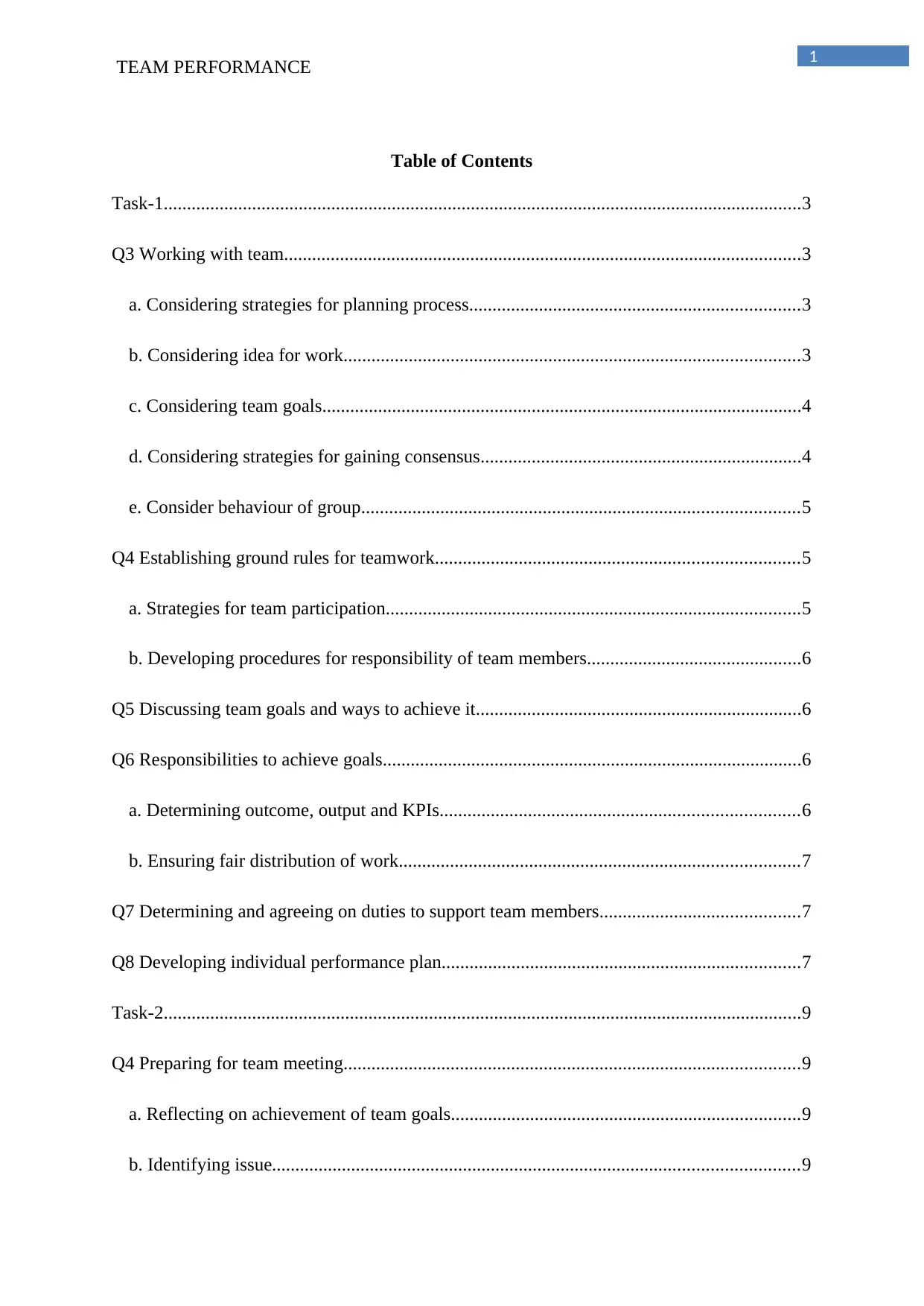
1
TEAM PERFORMANCE
Table of Contents
Task-1.........................................................................................................................................3
Q3 Working with team...............................................................................................................3
a. Considering strategies for planning process.......................................................................3
b. Considering idea for work..................................................................................................3
c. Considering team goals.......................................................................................................4
d. Considering strategies for gaining consensus.....................................................................4
e. Consider behaviour of group..............................................................................................5
Q4 Establishing ground rules for teamwork..............................................................................5
a. Strategies for team participation.........................................................................................5
b. Developing procedures for responsibility of team members..............................................6
Q5 Discussing team goals and ways to achieve it......................................................................6
Q6 Responsibilities to achieve goals..........................................................................................6
a. Determining outcome, output and KPIs.............................................................................6
b. Ensuring fair distribution of work......................................................................................7
Q7 Determining and agreeing on duties to support team members...........................................7
Q8 Developing individual performance plan.............................................................................7
Task-2.........................................................................................................................................9
Q4 Preparing for team meeting..................................................................................................9
a. Reflecting on achievement of team goals...........................................................................9
b. Identifying issue.................................................................................................................9
TEAM PERFORMANCE
Table of Contents
Task-1.........................................................................................................................................3
Q3 Working with team...............................................................................................................3
a. Considering strategies for planning process.......................................................................3
b. Considering idea for work..................................................................................................3
c. Considering team goals.......................................................................................................4
d. Considering strategies for gaining consensus.....................................................................4
e. Consider behaviour of group..............................................................................................5
Q4 Establishing ground rules for teamwork..............................................................................5
a. Strategies for team participation.........................................................................................5
b. Developing procedures for responsibility of team members..............................................6
Q5 Discussing team goals and ways to achieve it......................................................................6
Q6 Responsibilities to achieve goals..........................................................................................6
a. Determining outcome, output and KPIs.............................................................................6
b. Ensuring fair distribution of work......................................................................................7
Q7 Determining and agreeing on duties to support team members...........................................7
Q8 Developing individual performance plan.............................................................................7
Task-2.........................................................................................................................................9
Q4 Preparing for team meeting..................................................................................................9
a. Reflecting on achievement of team goals...........................................................................9
b. Identifying issue.................................................................................................................9
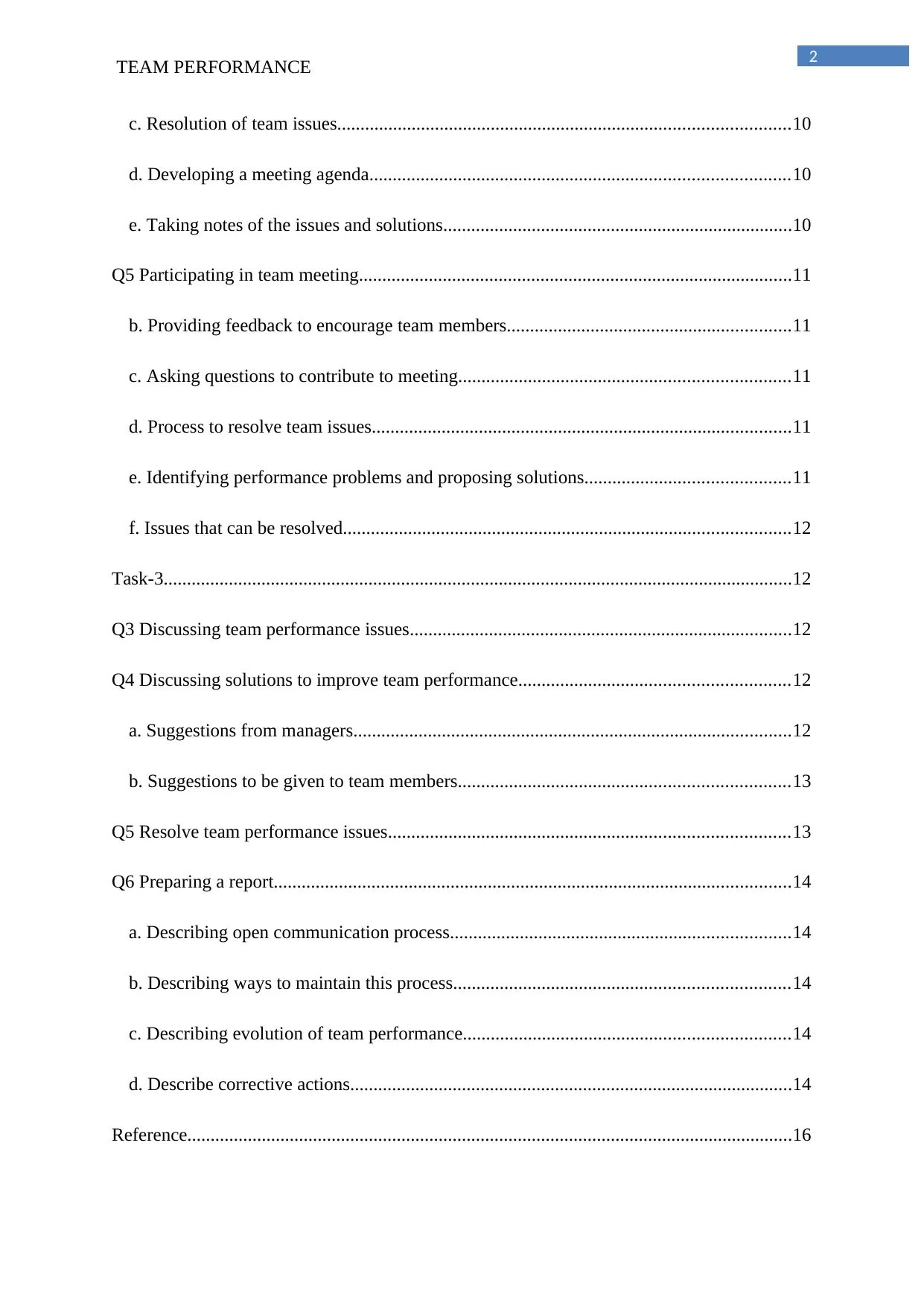
2
TEAM PERFORMANCE
c. Resolution of team issues.................................................................................................10
d. Developing a meeting agenda..........................................................................................10
e. Taking notes of the issues and solutions...........................................................................10
Q5 Participating in team meeting.............................................................................................11
b. Providing feedback to encourage team members.............................................................11
c. Asking questions to contribute to meeting.......................................................................11
d. Process to resolve team issues..........................................................................................11
e. Identifying performance problems and proposing solutions............................................11
f. Issues that can be resolved................................................................................................12
Task-3.......................................................................................................................................12
Q3 Discussing team performance issues..................................................................................12
Q4 Discussing solutions to improve team performance..........................................................12
a. Suggestions from managers..............................................................................................12
b. Suggestions to be given to team members.......................................................................13
Q5 Resolve team performance issues......................................................................................13
Q6 Preparing a report...............................................................................................................14
a. Describing open communication process.........................................................................14
b. Describing ways to maintain this process........................................................................14
c. Describing evolution of team performance......................................................................14
d. Describe corrective actions...............................................................................................14
Reference..................................................................................................................................16
TEAM PERFORMANCE
c. Resolution of team issues.................................................................................................10
d. Developing a meeting agenda..........................................................................................10
e. Taking notes of the issues and solutions...........................................................................10
Q5 Participating in team meeting.............................................................................................11
b. Providing feedback to encourage team members.............................................................11
c. Asking questions to contribute to meeting.......................................................................11
d. Process to resolve team issues..........................................................................................11
e. Identifying performance problems and proposing solutions............................................11
f. Issues that can be resolved................................................................................................12
Task-3.......................................................................................................................................12
Q3 Discussing team performance issues..................................................................................12
Q4 Discussing solutions to improve team performance..........................................................12
a. Suggestions from managers..............................................................................................12
b. Suggestions to be given to team members.......................................................................13
Q5 Resolve team performance issues......................................................................................13
Q6 Preparing a report...............................................................................................................14
a. Describing open communication process.........................................................................14
b. Describing ways to maintain this process........................................................................14
c. Describing evolution of team performance......................................................................14
d. Describe corrective actions...............................................................................................14
Reference..................................................................................................................................16
⊘ This is a preview!⊘
Do you want full access?
Subscribe today to unlock all pages.

Trusted by 1+ million students worldwide

3
TEAM PERFORMANCE
TEAM PERFORMANCE
Paraphrase This Document
Need a fresh take? Get an instant paraphrase of this document with our AI Paraphraser
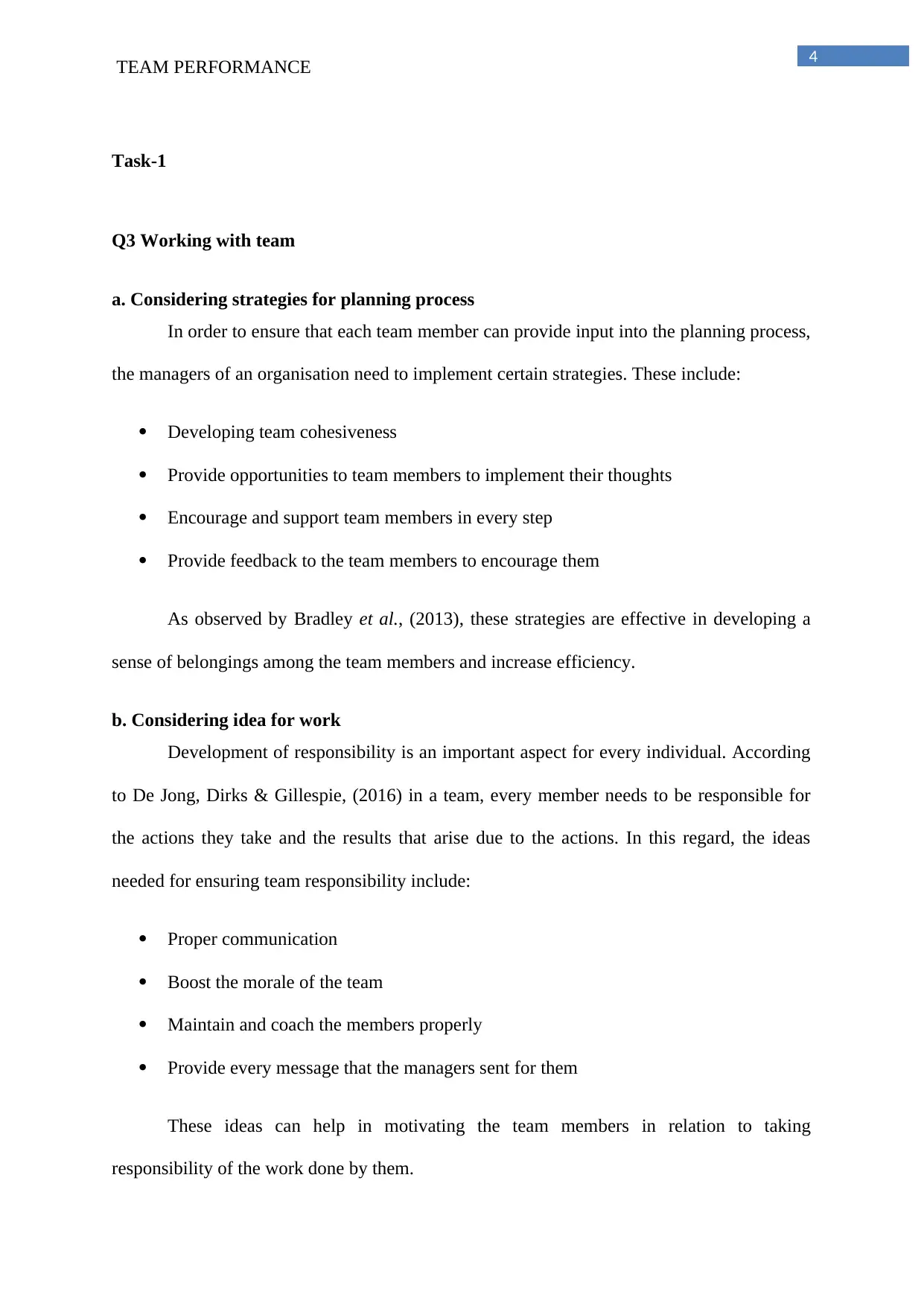
4
TEAM PERFORMANCE
Task-1
Q3 Working with team
a. Considering strategies for planning process
In order to ensure that each team member can provide input into the planning process,
the managers of an organisation need to implement certain strategies. These include:
Developing team cohesiveness
Provide opportunities to team members to implement their thoughts
Encourage and support team members in every step
Provide feedback to the team members to encourage them
As observed by Bradley et al., (2013), these strategies are effective in developing a
sense of belongings among the team members and increase efficiency.
b. Considering idea for work
Development of responsibility is an important aspect for every individual. According
to De Jong, Dirks & Gillespie, (2016) in a team, every member needs to be responsible for
the actions they take and the results that arise due to the actions. In this regard, the ideas
needed for ensuring team responsibility include:
Proper communication
Boost the morale of the team
Maintain and coach the members properly
Provide every message that the managers sent for them
These ideas can help in motivating the team members in relation to taking
responsibility of the work done by them.
TEAM PERFORMANCE
Task-1
Q3 Working with team
a. Considering strategies for planning process
In order to ensure that each team member can provide input into the planning process,
the managers of an organisation need to implement certain strategies. These include:
Developing team cohesiveness
Provide opportunities to team members to implement their thoughts
Encourage and support team members in every step
Provide feedback to the team members to encourage them
As observed by Bradley et al., (2013), these strategies are effective in developing a
sense of belongings among the team members and increase efficiency.
b. Considering idea for work
Development of responsibility is an important aspect for every individual. According
to De Jong, Dirks & Gillespie, (2016) in a team, every member needs to be responsible for
the actions they take and the results that arise due to the actions. In this regard, the ideas
needed for ensuring team responsibility include:
Proper communication
Boost the morale of the team
Maintain and coach the members properly
Provide every message that the managers sent for them
These ideas can help in motivating the team members in relation to taking
responsibility of the work done by them.

5
TEAM PERFORMANCE
c. Considering team goals
Every team need to formulate a setup goals that need to be achieved in order to maintain the
effectiveness of the team. These goals can help the team members to develop the best
approaches that are required for maintaining the effectiveness of the organisation. In this
regard, the goals that need to be maintained include:
Support the team members
Establish a proper team plan
Set timelines and deadlines
Delegate the tasks equally
According to D’Innocenzo, Mathieu & Kukenberger, (2016), one the best ways to
achieve the team goals is by ensuring that the team members are properly motivated and the
purpose of the formation of the team is clear to them. Without such knowledge, team goals
cannot be established.
d. Considering strategies for gaining consensus
As observed by de Jong, Dirks & Gillespie, (2015), every team consist of various
members with opinions that differ from one another. In this regard, it is necessary to develop
a sense of mutual agreement between the team members. The strategies to be considered
include:
Identify issues that can hamper the progress in the team
Encourage team to comprehend on issues
Develop communication between the members
Provide the team with scenarios that require teamwork to be done
TEAM PERFORMANCE
c. Considering team goals
Every team need to formulate a setup goals that need to be achieved in order to maintain the
effectiveness of the team. These goals can help the team members to develop the best
approaches that are required for maintaining the effectiveness of the organisation. In this
regard, the goals that need to be maintained include:
Support the team members
Establish a proper team plan
Set timelines and deadlines
Delegate the tasks equally
According to D’Innocenzo, Mathieu & Kukenberger, (2016), one the best ways to
achieve the team goals is by ensuring that the team members are properly motivated and the
purpose of the formation of the team is clear to them. Without such knowledge, team goals
cannot be established.
d. Considering strategies for gaining consensus
As observed by de Jong, Dirks & Gillespie, (2015), every team consist of various
members with opinions that differ from one another. In this regard, it is necessary to develop
a sense of mutual agreement between the team members. The strategies to be considered
include:
Identify issues that can hamper the progress in the team
Encourage team to comprehend on issues
Develop communication between the members
Provide the team with scenarios that require teamwork to be done
⊘ This is a preview!⊘
Do you want full access?
Subscribe today to unlock all pages.

Trusted by 1+ million students worldwide
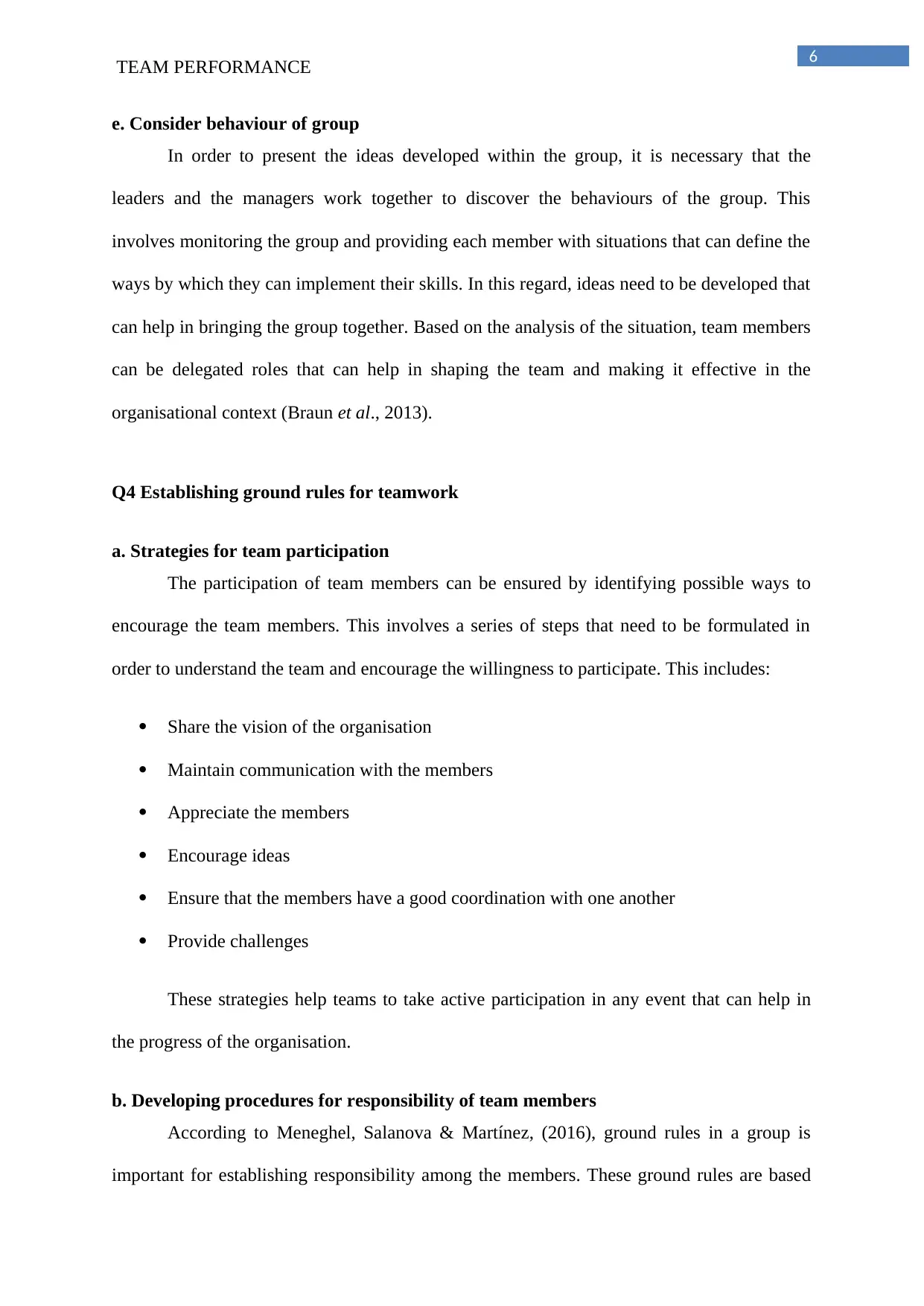
6
TEAM PERFORMANCE
e. Consider behaviour of group
In order to present the ideas developed within the group, it is necessary that the
leaders and the managers work together to discover the behaviours of the group. This
involves monitoring the group and providing each member with situations that can define the
ways by which they can implement their skills. In this regard, ideas need to be developed that
can help in bringing the group together. Based on the analysis of the situation, team members
can be delegated roles that can help in shaping the team and making it effective in the
organisational context (Braun et al., 2013).
Q4 Establishing ground rules for teamwork
a. Strategies for team participation
The participation of team members can be ensured by identifying possible ways to
encourage the team members. This involves a series of steps that need to be formulated in
order to understand the team and encourage the willingness to participate. This includes:
Share the vision of the organisation
Maintain communication with the members
Appreciate the members
Encourage ideas
Ensure that the members have a good coordination with one another
Provide challenges
These strategies help teams to take active participation in any event that can help in
the progress of the organisation.
b. Developing procedures for responsibility of team members
According to Meneghel, Salanova & Martínez, (2016), ground rules in a group is
important for establishing responsibility among the members. These ground rules are based
TEAM PERFORMANCE
e. Consider behaviour of group
In order to present the ideas developed within the group, it is necessary that the
leaders and the managers work together to discover the behaviours of the group. This
involves monitoring the group and providing each member with situations that can define the
ways by which they can implement their skills. In this regard, ideas need to be developed that
can help in bringing the group together. Based on the analysis of the situation, team members
can be delegated roles that can help in shaping the team and making it effective in the
organisational context (Braun et al., 2013).
Q4 Establishing ground rules for teamwork
a. Strategies for team participation
The participation of team members can be ensured by identifying possible ways to
encourage the team members. This involves a series of steps that need to be formulated in
order to understand the team and encourage the willingness to participate. This includes:
Share the vision of the organisation
Maintain communication with the members
Appreciate the members
Encourage ideas
Ensure that the members have a good coordination with one another
Provide challenges
These strategies help teams to take active participation in any event that can help in
the progress of the organisation.
b. Developing procedures for responsibility of team members
According to Meneghel, Salanova & Martínez, (2016), ground rules in a group is
important for establishing responsibility among the members. These ground rules are based
Paraphrase This Document
Need a fresh take? Get an instant paraphrase of this document with our AI Paraphraser
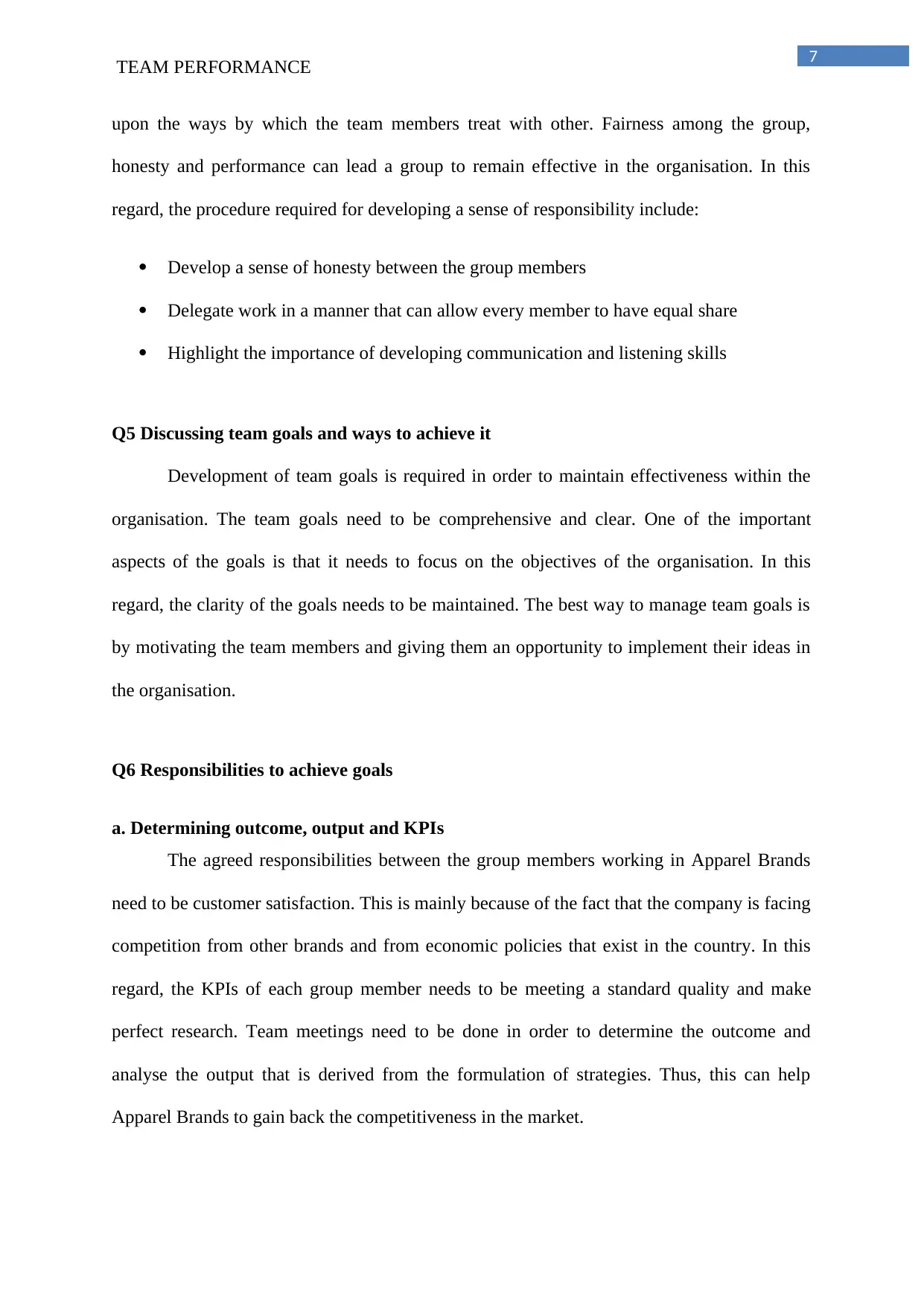
7
TEAM PERFORMANCE
upon the ways by which the team members treat with other. Fairness among the group,
honesty and performance can lead a group to remain effective in the organisation. In this
regard, the procedure required for developing a sense of responsibility include:
Develop a sense of honesty between the group members
Delegate work in a manner that can allow every member to have equal share
Highlight the importance of developing communication and listening skills
Q5 Discussing team goals and ways to achieve it
Development of team goals is required in order to maintain effectiveness within the
organisation. The team goals need to be comprehensive and clear. One of the important
aspects of the goals is that it needs to focus on the objectives of the organisation. In this
regard, the clarity of the goals needs to be maintained. The best way to manage team goals is
by motivating the team members and giving them an opportunity to implement their ideas in
the organisation.
Q6 Responsibilities to achieve goals
a. Determining outcome, output and KPIs
The agreed responsibilities between the group members working in Apparel Brands
need to be customer satisfaction. This is mainly because of the fact that the company is facing
competition from other brands and from economic policies that exist in the country. In this
regard, the KPIs of each group member needs to be meeting a standard quality and make
perfect research. Team meetings need to be done in order to determine the outcome and
analyse the output that is derived from the formulation of strategies. Thus, this can help
Apparel Brands to gain back the competitiveness in the market.
TEAM PERFORMANCE
upon the ways by which the team members treat with other. Fairness among the group,
honesty and performance can lead a group to remain effective in the organisation. In this
regard, the procedure required for developing a sense of responsibility include:
Develop a sense of honesty between the group members
Delegate work in a manner that can allow every member to have equal share
Highlight the importance of developing communication and listening skills
Q5 Discussing team goals and ways to achieve it
Development of team goals is required in order to maintain effectiveness within the
organisation. The team goals need to be comprehensive and clear. One of the important
aspects of the goals is that it needs to focus on the objectives of the organisation. In this
regard, the clarity of the goals needs to be maintained. The best way to manage team goals is
by motivating the team members and giving them an opportunity to implement their ideas in
the organisation.
Q6 Responsibilities to achieve goals
a. Determining outcome, output and KPIs
The agreed responsibilities between the group members working in Apparel Brands
need to be customer satisfaction. This is mainly because of the fact that the company is facing
competition from other brands and from economic policies that exist in the country. In this
regard, the KPIs of each group member needs to be meeting a standard quality and make
perfect research. Team meetings need to be done in order to determine the outcome and
analyse the output that is derived from the formulation of strategies. Thus, this can help
Apparel Brands to gain back the competitiveness in the market.
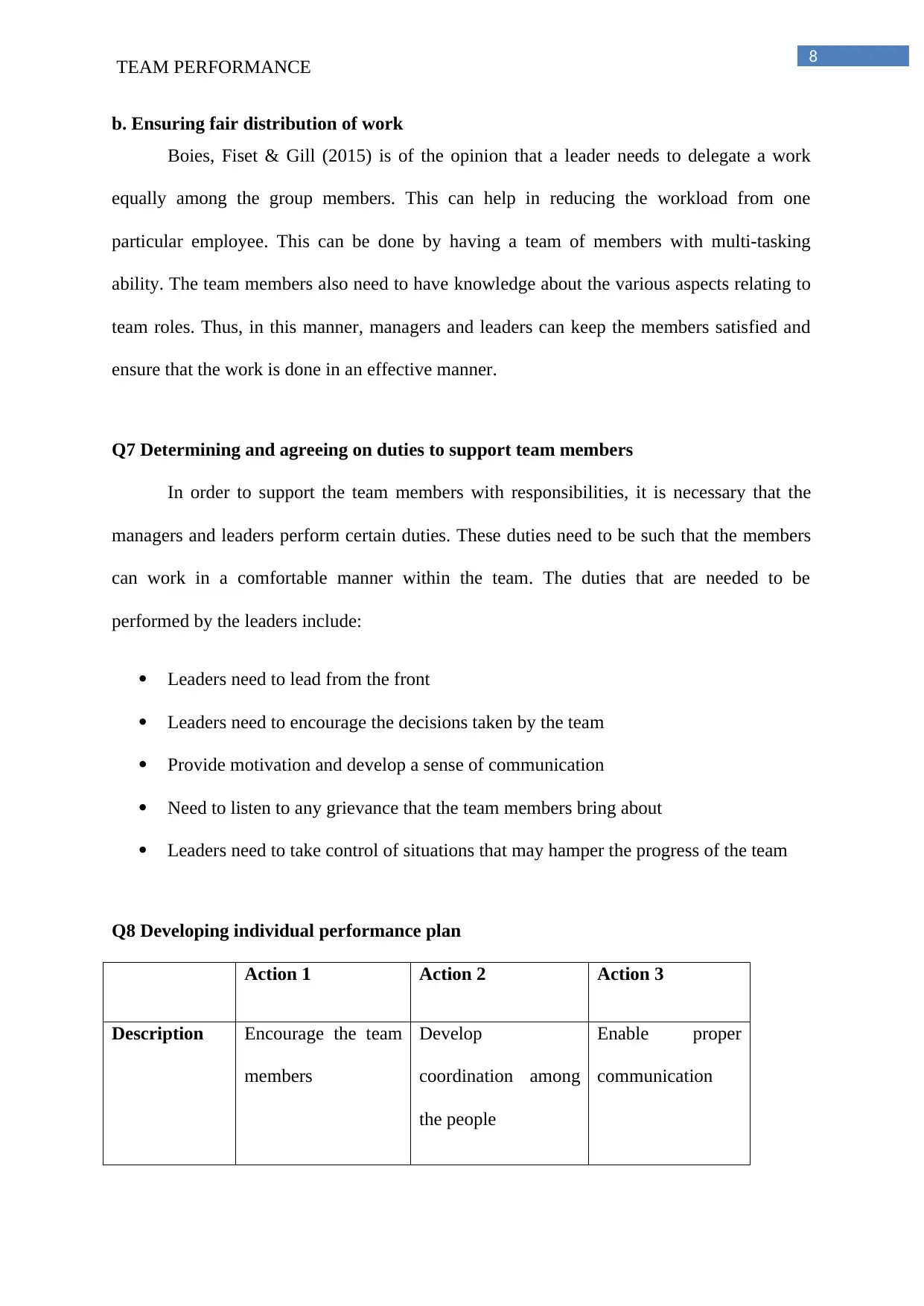
8
TEAM PERFORMANCE
b. Ensuring fair distribution of work
Boies, Fiset & Gill (2015) is of the opinion that a leader needs to delegate a work
equally among the group members. This can help in reducing the workload from one
particular employee. This can be done by having a team of members with multi-tasking
ability. The team members also need to have knowledge about the various aspects relating to
team roles. Thus, in this manner, managers and leaders can keep the members satisfied and
ensure that the work is done in an effective manner.
Q7 Determining and agreeing on duties to support team members
In order to support the team members with responsibilities, it is necessary that the
managers and leaders perform certain duties. These duties need to be such that the members
can work in a comfortable manner within the team. The duties that are needed to be
performed by the leaders include:
Leaders need to lead from the front
Leaders need to encourage the decisions taken by the team
Provide motivation and develop a sense of communication
Need to listen to any grievance that the team members bring about
Leaders need to take control of situations that may hamper the progress of the team
Q8 Developing individual performance plan
Action 1 Action 2 Action 3
Description Encourage the team
members
Develop
coordination among
the people
Enable proper
communication
TEAM PERFORMANCE
b. Ensuring fair distribution of work
Boies, Fiset & Gill (2015) is of the opinion that a leader needs to delegate a work
equally among the group members. This can help in reducing the workload from one
particular employee. This can be done by having a team of members with multi-tasking
ability. The team members also need to have knowledge about the various aspects relating to
team roles. Thus, in this manner, managers and leaders can keep the members satisfied and
ensure that the work is done in an effective manner.
Q7 Determining and agreeing on duties to support team members
In order to support the team members with responsibilities, it is necessary that the
managers and leaders perform certain duties. These duties need to be such that the members
can work in a comfortable manner within the team. The duties that are needed to be
performed by the leaders include:
Leaders need to lead from the front
Leaders need to encourage the decisions taken by the team
Provide motivation and develop a sense of communication
Need to listen to any grievance that the team members bring about
Leaders need to take control of situations that may hamper the progress of the team
Q8 Developing individual performance plan
Action 1 Action 2 Action 3
Description Encourage the team
members
Develop
coordination among
the people
Enable proper
communication
⊘ This is a preview!⊘
Do you want full access?
Subscribe today to unlock all pages.

Trusted by 1+ million students worldwide
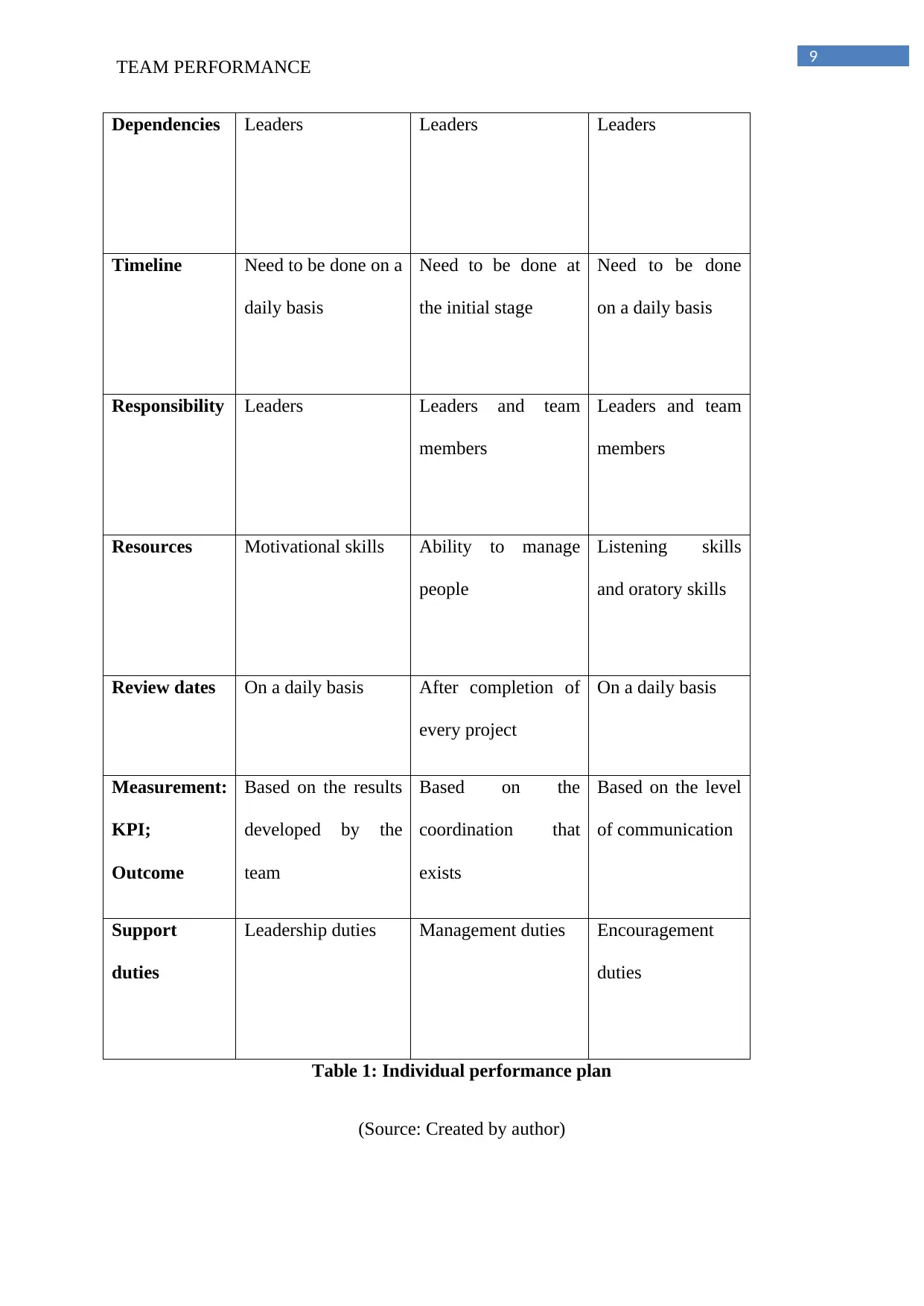
9
TEAM PERFORMANCE
Dependencies Leaders Leaders Leaders
Timeline Need to be done on a
daily basis
Need to be done at
the initial stage
Need to be done
on a daily basis
Responsibility Leaders Leaders and team
members
Leaders and team
members
Resources Motivational skills Ability to manage
people
Listening skills
and oratory skills
Review dates On a daily basis After completion of
every project
On a daily basis
Measurement:
KPI;
Outcome
Based on the results
developed by the
team
Based on the
coordination that
exists
Based on the level
of communication
Support
duties
Leadership duties Management duties Encouragement
duties
Table 1: Individual performance plan
(Source: Created by author)
TEAM PERFORMANCE
Dependencies Leaders Leaders Leaders
Timeline Need to be done on a
daily basis
Need to be done at
the initial stage
Need to be done
on a daily basis
Responsibility Leaders Leaders and team
members
Leaders and team
members
Resources Motivational skills Ability to manage
people
Listening skills
and oratory skills
Review dates On a daily basis After completion of
every project
On a daily basis
Measurement:
KPI;
Outcome
Based on the results
developed by the
team
Based on the
coordination that
exists
Based on the level
of communication
Support
duties
Leadership duties Management duties Encouragement
duties
Table 1: Individual performance plan
(Source: Created by author)
Paraphrase This Document
Need a fresh take? Get an instant paraphrase of this document with our AI Paraphraser
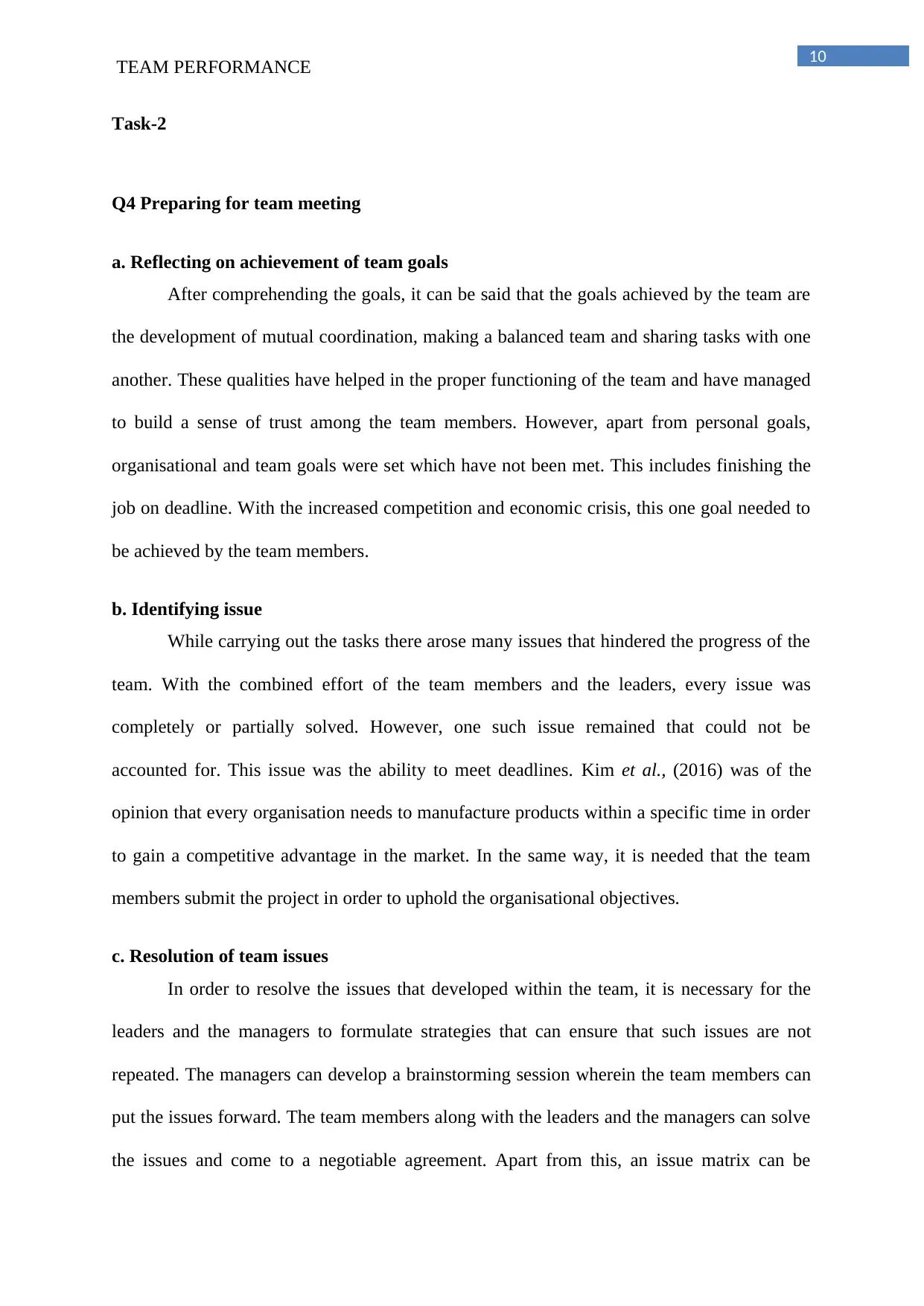
10
TEAM PERFORMANCE
Task-2
Q4 Preparing for team meeting
a. Reflecting on achievement of team goals
After comprehending the goals, it can be said that the goals achieved by the team are
the development of mutual coordination, making a balanced team and sharing tasks with one
another. These qualities have helped in the proper functioning of the team and have managed
to build a sense of trust among the team members. However, apart from personal goals,
organisational and team goals were set which have not been met. This includes finishing the
job on deadline. With the increased competition and economic crisis, this one goal needed to
be achieved by the team members.
b. Identifying issue
While carrying out the tasks there arose many issues that hindered the progress of the
team. With the combined effort of the team members and the leaders, every issue was
completely or partially solved. However, one such issue remained that could not be
accounted for. This issue was the ability to meet deadlines. Kim et al., (2016) was of the
opinion that every organisation needs to manufacture products within a specific time in order
to gain a competitive advantage in the market. In the same way, it is needed that the team
members submit the project in order to uphold the organisational objectives.
c. Resolution of team issues
In order to resolve the issues that developed within the team, it is necessary for the
leaders and the managers to formulate strategies that can ensure that such issues are not
repeated. The managers can develop a brainstorming session wherein the team members can
put the issues forward. The team members along with the leaders and the managers can solve
the issues and come to a negotiable agreement. Apart from this, an issue matrix can be
TEAM PERFORMANCE
Task-2
Q4 Preparing for team meeting
a. Reflecting on achievement of team goals
After comprehending the goals, it can be said that the goals achieved by the team are
the development of mutual coordination, making a balanced team and sharing tasks with one
another. These qualities have helped in the proper functioning of the team and have managed
to build a sense of trust among the team members. However, apart from personal goals,
organisational and team goals were set which have not been met. This includes finishing the
job on deadline. With the increased competition and economic crisis, this one goal needed to
be achieved by the team members.
b. Identifying issue
While carrying out the tasks there arose many issues that hindered the progress of the
team. With the combined effort of the team members and the leaders, every issue was
completely or partially solved. However, one such issue remained that could not be
accounted for. This issue was the ability to meet deadlines. Kim et al., (2016) was of the
opinion that every organisation needs to manufacture products within a specific time in order
to gain a competitive advantage in the market. In the same way, it is needed that the team
members submit the project in order to uphold the organisational objectives.
c. Resolution of team issues
In order to resolve the issues that developed within the team, it is necessary for the
leaders and the managers to formulate strategies that can ensure that such issues are not
repeated. The managers can develop a brainstorming session wherein the team members can
put the issues forward. The team members along with the leaders and the managers can solve
the issues and come to a negotiable agreement. Apart from this, an issue matrix can be
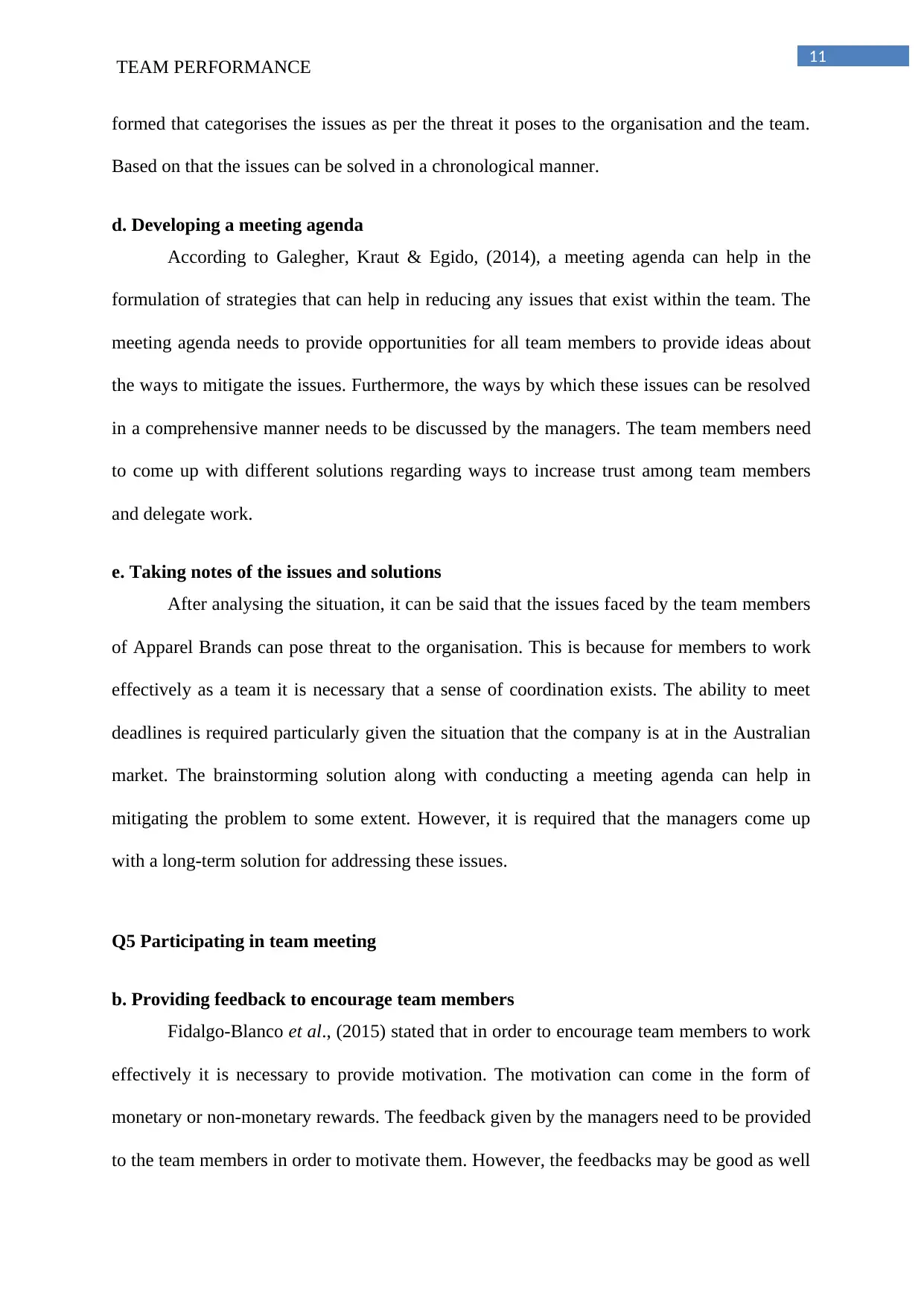
11
TEAM PERFORMANCE
formed that categorises the issues as per the threat it poses to the organisation and the team.
Based on that the issues can be solved in a chronological manner.
d. Developing a meeting agenda
According to Galegher, Kraut & Egido, (2014), a meeting agenda can help in the
formulation of strategies that can help in reducing any issues that exist within the team. The
meeting agenda needs to provide opportunities for all team members to provide ideas about
the ways to mitigate the issues. Furthermore, the ways by which these issues can be resolved
in a comprehensive manner needs to be discussed by the managers. The team members need
to come up with different solutions regarding ways to increase trust among team members
and delegate work.
e. Taking notes of the issues and solutions
After analysing the situation, it can be said that the issues faced by the team members
of Apparel Brands can pose threat to the organisation. This is because for members to work
effectively as a team it is necessary that a sense of coordination exists. The ability to meet
deadlines is required particularly given the situation that the company is at in the Australian
market. The brainstorming solution along with conducting a meeting agenda can help in
mitigating the problem to some extent. However, it is required that the managers come up
with a long-term solution for addressing these issues.
Q5 Participating in team meeting
b. Providing feedback to encourage team members
Fidalgo-Blanco et al., (2015) stated that in order to encourage team members to work
effectively it is necessary to provide motivation. The motivation can come in the form of
monetary or non-monetary rewards. The feedback given by the managers need to be provided
to the team members in order to motivate them. However, the feedbacks may be good as well
TEAM PERFORMANCE
formed that categorises the issues as per the threat it poses to the organisation and the team.
Based on that the issues can be solved in a chronological manner.
d. Developing a meeting agenda
According to Galegher, Kraut & Egido, (2014), a meeting agenda can help in the
formulation of strategies that can help in reducing any issues that exist within the team. The
meeting agenda needs to provide opportunities for all team members to provide ideas about
the ways to mitigate the issues. Furthermore, the ways by which these issues can be resolved
in a comprehensive manner needs to be discussed by the managers. The team members need
to come up with different solutions regarding ways to increase trust among team members
and delegate work.
e. Taking notes of the issues and solutions
After analysing the situation, it can be said that the issues faced by the team members
of Apparel Brands can pose threat to the organisation. This is because for members to work
effectively as a team it is necessary that a sense of coordination exists. The ability to meet
deadlines is required particularly given the situation that the company is at in the Australian
market. The brainstorming solution along with conducting a meeting agenda can help in
mitigating the problem to some extent. However, it is required that the managers come up
with a long-term solution for addressing these issues.
Q5 Participating in team meeting
b. Providing feedback to encourage team members
Fidalgo-Blanco et al., (2015) stated that in order to encourage team members to work
effectively it is necessary to provide motivation. The motivation can come in the form of
monetary or non-monetary rewards. The feedback given by the managers need to be provided
to the team members in order to motivate them. However, the feedbacks may be good as well
⊘ This is a preview!⊘
Do you want full access?
Subscribe today to unlock all pages.

Trusted by 1+ million students worldwide
1 out of 19
Related Documents
Your All-in-One AI-Powered Toolkit for Academic Success.
+13062052269
info@desklib.com
Available 24*7 on WhatsApp / Email
![[object Object]](/_next/static/media/star-bottom.7253800d.svg)
Unlock your academic potential
Copyright © 2020–2025 A2Z Services. All Rights Reserved. Developed and managed by ZUCOL.



